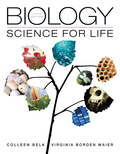
Concept explainers
To write:
The reason behind a column of water in a xylem tube that remains intact despite tremendous tension.
Introduction:
Water and minerals are taken from the soil, together called xylem sap, travel up the xylem, and the cells that help absorb water inside a plant. The tendency for similar molecules to bond such as molecules of water linked by hydrogen bonding, is said as cohesion. The tendency for unlike molecules to stick together, such as water is hydrogen-bonded to other polar molecules, is called adhesion.
Explanation of Solution
The pulling force on a column of xylem sap is generated by the water evaporated from leaves. Stomata, the pores on leaf surfaces, control the exchange of gas and water loss in plants. From stomata, when water evaporates, the forces of adhesion and cohesion on the water molecules that remain inside the leaves create tension or negative water pressure. Tension is the force that allows the plunger to pull a column of water into a syringe.
Water adhesion to xylem cell walls and cohesion to other molecules of water even under extreme tension maintain continuity of xylem sap. Tension in plants causes water molecules to be drawn out into the leaf from the xylem to take the place of water that has evaporated. This in turn, increases tension on the water molecules immediately below them in the xylem, causing water molecules to move toward the leaves, roots and the soil.
Tension in leaf cell walls is important because it helps to maintain the transpiration stream. When water is sucked through the xylem, it creates low pressure in the xylem. The continuity is maintained together by cohesion and adhesion during transpiration.
Want to see more full solutions like this?
- please fill in the empty sports, thank you!arrow_forwardIn one paragraph show how atoms and they're structure are related to the structure of dna and proteins. Talk about what atoms are. what they're made of, why chemical bonding is important to DNA?arrow_forwardWhat are the structure and properties of atoms and chemical bonds (especially how they relate to DNA and proteins).arrow_forward
- The Sentinel Cell: Nature’s Answer to Cancer?arrow_forwardMolecular Biology Question You are working to characterize a novel protein in mice. Analysis shows that high levels of the primary transcript that codes for this protein are found in tissue from the brain, muscle, liver, and pancreas. However, an antibody that recognizes the C-terminal portion of the protein indicates that the protein is present in brain, muscle, and liver, but not in the pancreas. What is the most likely explanation for this result?arrow_forwardMolecular Biology Explain/discuss how “slow stop” and “quick/fast stop” mutants wereused to identify different protein involved in DNA replication in E. coli.arrow_forward
- Molecular Biology Question A gene that codes for a protein was removed from a eukaryotic cell and inserted into a prokaryotic cell. Although the gene was successfully transcribed and translated, it produced a different protein than it produced in the eukaryotic cell. What is the most likely explanation?arrow_forwardMolecular Biology LIST three characteristics of origins of replicationarrow_forwardMolecular Biology Question Please help. Thank you For E coli DNA polymerase III, give the structure and function of the b-clamp sub-complex. Describe how the structure of this sub-complex is important for it’s function.arrow_forward
 Biology (MindTap Course List)BiologyISBN:9781337392938Author:Eldra Solomon, Charles Martin, Diana W. Martin, Linda R. BergPublisher:Cengage Learning
Biology (MindTap Course List)BiologyISBN:9781337392938Author:Eldra Solomon, Charles Martin, Diana W. Martin, Linda R. BergPublisher:Cengage Learning
 Biology 2eBiologyISBN:9781947172517Author:Matthew Douglas, Jung Choi, Mary Ann ClarkPublisher:OpenStax
Biology 2eBiologyISBN:9781947172517Author:Matthew Douglas, Jung Choi, Mary Ann ClarkPublisher:OpenStax Biology: The Unity and Diversity of Life (MindTap...BiologyISBN:9781337408332Author:Cecie Starr, Ralph Taggart, Christine Evers, Lisa StarrPublisher:Cengage Learning
Biology: The Unity and Diversity of Life (MindTap...BiologyISBN:9781337408332Author:Cecie Starr, Ralph Taggart, Christine Evers, Lisa StarrPublisher:Cengage Learning Biology: The Unity and Diversity of Life (MindTap...BiologyISBN:9781305073951Author:Cecie Starr, Ralph Taggart, Christine Evers, Lisa StarrPublisher:Cengage Learning
Biology: The Unity and Diversity of Life (MindTap...BiologyISBN:9781305073951Author:Cecie Starr, Ralph Taggart, Christine Evers, Lisa StarrPublisher:Cengage Learning





